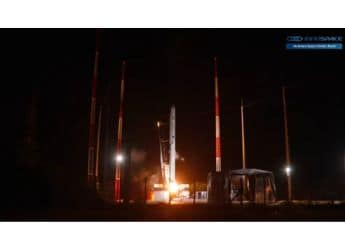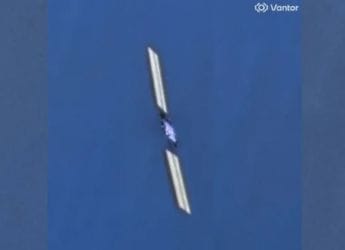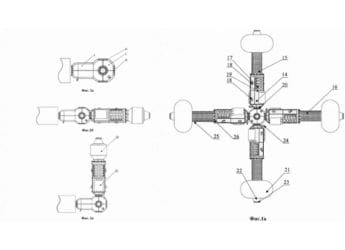- Home
- Science
- Science News
- NASA CODEX Telescope on ISS Reveals Hidden Secrets of the Sun’s Corona
NASA CODEX Telescope on ISS Reveals Hidden Secrets of the Sun’s Corona
NASA’s Coronal Diagnostic Experiment (CODEX) has released its first set of images showcasing never-before-seen details of the Sun’s outer atmosphere.

Photo Credit: NASA/KASI/INAF/CODEX
CODEX is the first coronagraph to measure both solar wind speed and temperature
A mini solar telescope aboard the International Space Station caught the first-ever images, which reveal the subtle and never-seen changes in the outer atmosphere of the Sun. It is known as the Coronal Diagnostic Experiment (CODEX) and has been designed to understand the solar corona, the outer layer of the Sun, in depth. This mini telescope functions like a coronagraph, which blocks the Sun's disk to imitate the total solar eclipse. CODEX was delivered through SpaceX Dragon on November 5, 2024. It was mounted on the ISS using the Canadarm2 robotic arm on November 9, 2025.
Revolutionising Solar Observation
According to the report by NASA, the unique design of CODEX consists of an occulting disk the size of a tennis ball held by three arms made up of metal. It allows it to block the intense sunlight when imaging the faint corona. The first images were revealed on June 10, 2025, at the time of the American Astronomical Society's meeting in Alaska. These comprised pictures of coronal streamers and footage of the temperature fluctuations in the outer corona over many days. This offers a fresh perspective on solar dynamics.
Measuring Solar Wind Like Never Before
CODEX is unlike the previous coronagraphs as it is the first to measure both the speed and temperature of the solar wind. There is a constant flow of superhot particles from the Sun. With the help of four narrowband filters, in which two are used for determining the temperature and two for speed, astronomers compare brightness to decode these properties, which helps in solving the mystery of how the solar wind reaches 1.8 million degrees Fahrenheit.
Tackling the Solar Weather Challenge
To know the solar wind, it is crucial to predict the geomagnetic storms triggered by the coronal holes. Shortly, the storms observed on June 13, 2025 and June 25, 2025, caused auroras because of these events. After refining the analysis of solar wind, CODEX can help in mitigating and forecasting such kind of disturbances.
A Timely Launch Amid Solar Peak
NASA's CODEX started operations at a suitable moment, just as the current solar maximum comes to its end. As the magnetic field of the Sun shifts during the solar battle zone, CODEX is ready to catch the critical data that can change our understanding of the weather in space.
Get your daily dose of tech news, reviews, and insights, in under 80 characters on Gadgets 360 Turbo. Connect with fellow tech lovers on our Forum. Follow us on X, Facebook, WhatsApp, Threads and Google News for instant updates. Catch all the action on our YouTube channel.
Related Stories
- Samsung Galaxy Unpacked 2025
- ChatGPT
- Redmi Note 14 Pro+
- iPhone 16
- Apple Vision Pro
- Oneplus 12
- OnePlus Nord CE 3 Lite 5G
- iPhone 13
- Xiaomi 14 Pro
- Oppo Find N3
- Tecno Spark Go (2023)
- Realme V30
- Best Phones Under 25000
- Samsung Galaxy S24 Series
- Cryptocurrency
- iQoo 12
- Samsung Galaxy S24 Ultra
- Giottus
- Samsung Galaxy Z Flip 5
- Apple 'Scary Fast'
- Housefull 5
- GoPro Hero 12 Black Review
- Invincible Season 2
- JioGlass
- HD Ready TV
- Laptop Under 50000
- Smartwatch Under 10000
- Latest Mobile Phones
- Compare Phones
- Huawei Nova 15
- Huawei Nova 15 Pro
- Huawei Nova 15 Ultra
- OnePlus 15R
- Realme Narzo 90x 5G
- Realme Narzo 90 5G
- Vivo S50 Pro Mini
- Vivo S50
- Asus ProArt P16
- MacBook Pro 14-inch (M5, 2025)
- Huawei MatePad 11.5 (2026)
- OnePlus Pad Go 2 (5G)
- Huawei Watch 10th Anniversary Edition
- OnePlus Watch Lite
- Acerpure Nitro Z Series 100-inch QLED TV
- Samsung 43 Inch LED Ultra HD (4K) Smart TV (UA43UE81AFULXL)
- Asus ROG Ally
- Nintendo Switch Lite
- Haier 1.6 Ton 5 Star Inverter Split AC (HSU19G-MZAID5BN-INV)
- Haier 1.6 Ton 5 Star Inverter Split AC (HSU19G-MZAIM5BN-INV)

















